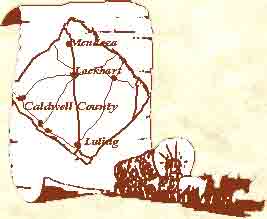
|
Priarie Lea A community in southwestern Caldwell County near the San Marcos River ten miles southwest of Lockhart, was built on the 1820 land grant of Joe Martin of Gonzales. It is Caldwell County's oldest community and was named by Sam Houston for Margaret Lea Houston, who later became his bride. Prairie Lea's first settler, in 1839, was Edmund Bellinger, who participated in the battle of San Jacinto and the battle of Plum Creek. Other early Prairie Lea settlers were largely slaveholding families. Community growth followed the establishment of a sawmill, gristmill, and gin by Thomas Mooney on the nearby San Marcos River. Remains of the early dam can still be seen. Prairie Lea's first school was organized in 1848 in a log cabin, which was also used for church services. The first store was opened by James Hugh Callihan in 1849. In 1852 the Masonic order opened the Prairie Lea Academy and in 1860 chartered the Prairie Lea Female Institute. By 1853 the town had a hotel, two stores, a post office, and a school, and in 1878 the Grange constructed a building that also served as a school. During the Civil War Prairie Lea men served with Hood's Texas Brigade in the Army of Northern Virginia and with the botched Sibley Campaign to New Mexico. Stranded and starving members of that expedition were brought home by a community committee, which in June 1862 organized the necessary wagons, mules, harness, food, and supplies. Other food supplies, paid for by a special county tax and donations, were distributed from the Mooney gristmill to those county families made destitute by the Civil War. Reconstruction brought hardship to the town. Neither the stationing of troops nor appeals to the Freedmen's Bureau could fully establish order or prevent violence. Some Prairie Lea families left for Mexico. Peace and prosperity had returned to Prairie Lea by the 1870s, but in 1877 a fire destroyed the town's seventeen stores. Prairie Lea had 100 residents in 1884, and gristmills, cotton gins, two churches, and a school by 1890, when the town shipped cotton. By 1914 three general stores and two blacksmiths had been added, and the population was 350. Development of the nearby Luling oilfield in the 1920s increased Prairie Lea's population. A five-room school was built in 1925, and higher enrollment necessitated the addition of five more rooms the following year. By the 1940s the Prairie Lea school district also served nearby Fentress and Stairtown. This cooperative educational effort was still the focus of community life in 1990 for Prairie Lea's population of 100. The town had two churches and five small businesses. In 2000 the population was 255 with eight businesses.
Source
Texas State Historical Association ~ Barbara Stock |